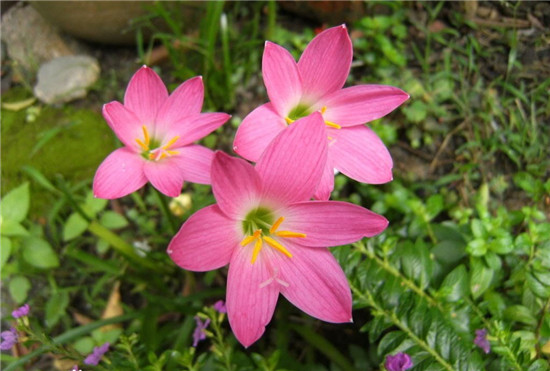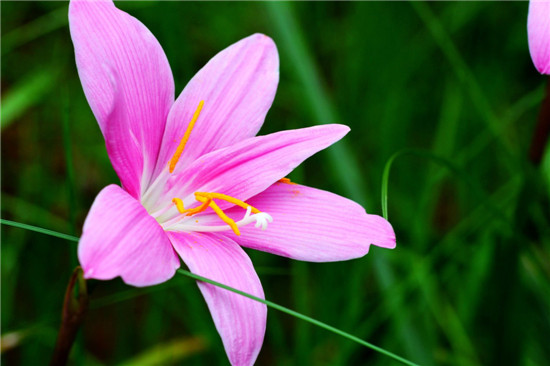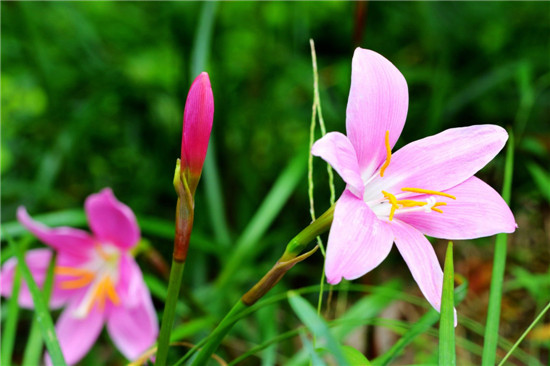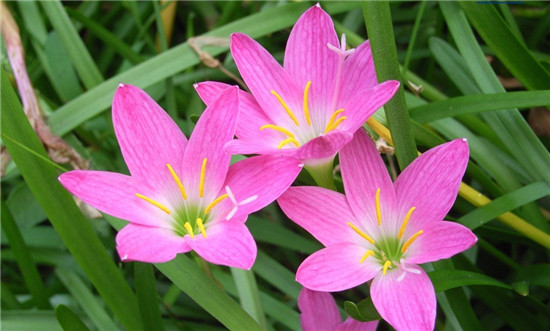Daily cultivation of Carthamus tinctorius
Safflower onion orchid is a plant of the genus Lycoris, which is an herb native to Mexico and is now widely cultivated all over the world. Next, let's take a look at the cultivation of safflower onion orchid.

Safflower onion orchid, also known as wind and rain flower, leek orchid, is a perennial herb of Lycoris family. Originally from Mexico. Perennial bulbous herbs. Bark bulb ovate, with light brown skin, short neck. Basal leaves 5-6, sublinear, flattened, slightly fleshy, bright green, 20-30cm long. Scape drawn from the foliage, terminal flower, pink, funnelform, perianth tube ca. 2cm, lobes Obovate, apex obtuse, flowers larger. Capsule, subglobose. Seeds flat, black.
Safflower onion orchid low clump, flat leaves, many flowers, flower stems extracted from the leaves, terminal more, such as planting in pieces, flowering when a rose-red, very beautiful, so it is a good flowering ground cover plant, flowering from June to September, summer and autumn flowering, can bloom 2-3 times a year.

Safflower onion and orchid like warmth and sunshine, but also withstand semi-overcast and dampness. It is suitable for sandy loam with good drainage and rich humus. It is more hardy and the underground bulb can survive the winter in the open field in East China.
Safflower onion orchid can be propagated by seed and can be planted by split plant or bulb, which can be carried out all year round, but it is the best in spring. As long as the root of the ball is dug up, 3-5 balls are planted in each place and watered to maintain proper humidity, it is very easy to survive. When digging up the bulbs, be careful not to hurt them. If there are too many leaves and flower stems, cut off the upper part and keep the complete bulb and 6-8 cm leaves for planting. If the bulbs have germinated buds and fully watered after branching, safflower onion orchids can still bloom.

Safflower onion orchid planted in the garden, choose a sunny, warm, sheltered place, the growth and flowering period of 3-4 times topdressing, can flourish leaves and flowers. Cultivated in the open field in the middle and lower reaches of the Yangtze River, after severe frost in winter, the old leaves withered and the bulbs could stay for the winter and blossom as usual the following year. The potted soil was mixed with 2 parts of loam, 1 part of rotten leaf soil and peat with a small amount of fine sand, and a small amount of bone powder and mature compost. Safflower onion orchid growth period should have sufficient sunlight and moisture, a batch of flowers withered, suspended watering for 7-8 weeks and then resumed watering, so dry and wet interval, can blossom 2-3 stubble in a year.

Organic fertilizer can be used once every 2-3 months to increase phosphorus and potassium fertilizer proportionally, which can promote bulb hypertrophy and flowering of safflower onion orchid. When the plants are clustered and crowded, the ramets must be forced. Strong in nature, drought-resistant and high-temperature resistant, easy to cultivate, and the suitable temperature for growth is 22-30 degrees. The depth of introduction and planting is slightly exposed at the top of the bulb, and the bulb is divided once every 2-3 years. After a batch of flowers fade, the water should be controlled for 50-60 days, and then the normal water supply should be restored. Such alternation of dry and wet can promote the flowering of safflower onion orchid for many times, and it can blossom 2-3 times a year.
These are all the contents of the daily planting of safflower and onion orchids that I have summarized for you. I hope this article can help you. Please continue to follow us.
Related
- Wuhan Hospital Iron Tree Blooming Result Was Instantly Frightened by the Gardener Master
- Which variety of camellia is the most fragrant and best? Which one do you like best?
- What is the small blue coat, the breeding methods and matters needing attention of the succulent plant
- Dormancy time and maintenance management of succulent plants during dormancy
- Minas succulent how to raise, Minas succulent plant pictures
- What are the varieties of winter succulent plants
- How to raise succulent plants in twelve rolls? let's take a look at some experience of breeding twelve rolls.
- Attention should be paid to water control for succulent plants during dormant period (winter and summer)
- Watering experience of twelve rolls of succulent plants
- Techniques for fertilizing succulent plants. An article will let you know how to fertilize succulent plants.



